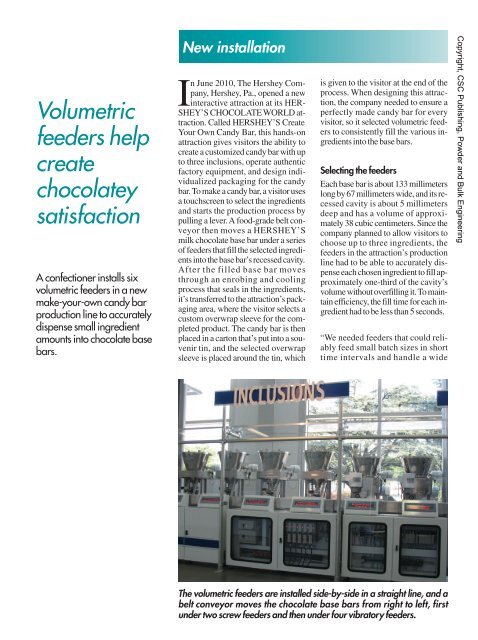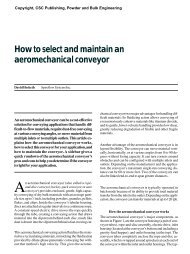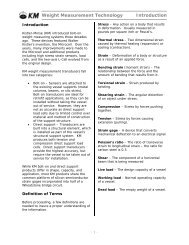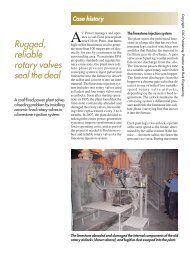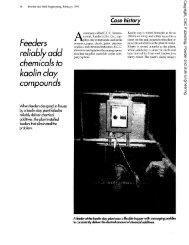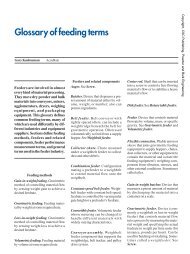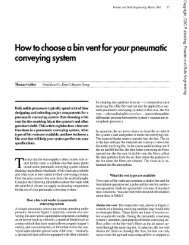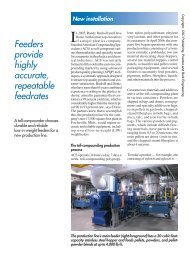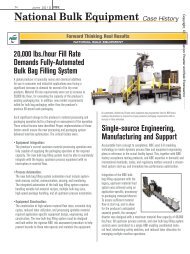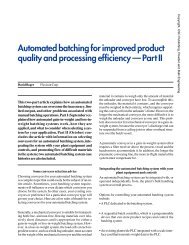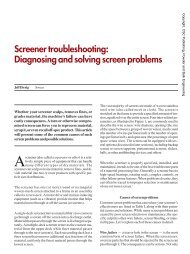Schenck Accurate - Powder and Bulk Engineering Magazine
Schenck Accurate - Powder and Bulk Engineering Magazine
Schenck Accurate - Powder and Bulk Engineering Magazine
Create successful ePaper yourself
Turn your PDF publications into a flip-book with our unique Google optimized e-Paper software.
Volumetricfeeders helpcreatechocolateysatisfactionA confectioner installs sixvolumetric feeders in a newmake-your-own c<strong>and</strong>y barproduction line to accuratelydispense small ingredientamounts into chocolate basebars.New installationIn June 2010, The Hershey Company,Hershey, Pa., opened a newinteractive attraction at its HER-SHEY’S CHOCOLATEWORLD attraction.Called HERSHEY’S CreateYour Own C<strong>and</strong>y Bar, this h<strong>and</strong>s-onattraction gives visitors the ability tocreate a customized c<strong>and</strong>y bar with upto three inclusions, operate authenticfactory equipment, <strong>and</strong> design individualizedpackaging for the c<strong>and</strong>ybar.To make a c<strong>and</strong>y bar, a visitor usesa touchscreen to select the ingredients<strong>and</strong> starts the production process bypulling a lever.A food-grade belt conveyorthen moves a HERSHEY’Smilk chocolate base bar under a seriesof feeders that fill the selected ingredientsintothebasebar’srecessedcavity.After the filled base bar movesthrough an enrobing <strong>and</strong> coolingprocess that seals in the ingredients,it’s transferred to the attraction’s packagingarea, where the visitor selects acustom overwrap sleeve for the completedproduct. The c<strong>and</strong>y bar is thenplaced in a carton that’s put into a souvenirtin, <strong>and</strong> the selected overwrapsleeve is placed around the tin, whichis given to the visitor at the end of theprocess. When designing this attraction,the company needed to ensure aperfectly made c<strong>and</strong>y bar for everyvisitor, so it selected volumetric feedersto consistently fill the various ingredientsinto the base bars.Selecting the feedersEach base bar is about 133 millimeterslongby67millimeterswide,<strong>and</strong>itsrecessedcavity is about 5 millimetersdeep <strong>and</strong> has a volume of approximately38 cubic centimeters. Since thecompany planned to allow visitors tochoose up to three ingredients, thefeeders in the attraction’s productionline had to be able to accurately dispenseeachchoseningredienttofillapproximatelyone-third of the cavity’svolumewithoutoverfillingit.Tomaintainefficiency, the fill time for each ingredienthadtobelessthan5seconds.“We needed feeders that could reliablyfeed small batch sizes in shorttime intervals <strong>and</strong> h<strong>and</strong>le a wideCopyright, CSC Publishing, <strong>Powder</strong> <strong>and</strong> <strong>Bulk</strong> <strong>Engineering</strong>The volumetric feeders are installed side-by-side in a straight line, <strong>and</strong> abelt conveyor moves the chocolate base bars from right to left, firstunder two screw feeders <strong>and</strong> then under four vibratory feeders.
ange of ingredients with disparateparticle sizes <strong>and</strong> flow characteristics,”says Krista Cessna, Hershey associatestaff engineer. “For thisproject, we found that gravimetricfeeding wasn’t an option because ofthe small ingredient amounts <strong>and</strong>short fill times. So we contacted severalvolumetric feeder suppliers, <strong>and</strong>one of them wanted to conduct tests attheir test center, so I sent them a varietyof ingredients for testing.”This supplier, <strong>Schenck</strong>AccuRate, operatesa full-service test center at itsfacility inWhitewater,Wis., <strong>and</strong> manufactures<strong>and</strong> supplies volumetric <strong>and</strong>gravimetric feeders, vibratory feeders,weighfeeders, controls, customsystems, <strong>and</strong> other bulk solids h<strong>and</strong>lingequipment to the food, chemical,pharmaceutical, plastics, <strong>and</strong>other industries.The supplier conducted multiple teststo determine the ideal equipment <strong>and</strong>preliminary operating parameters forthe ingredients <strong>and</strong> sent the resultsback to the company. “I then took thebase bars to their test center, <strong>and</strong> weset up a belt conveyor <strong>and</strong> watched thefeeders fill the ingredients into thebase bar cavities,” says Cessna. “Thisallowed us to see that the various ingredientshave different trajectorieswhen they discharge from a feeder<strong>and</strong> that they bounce differently whenthey hit the base bar, causing some ofthem to spill out. We found that thedischarge height is critical to not havingthe pieces bounce out, so we adjustedthe feeder’s height <strong>and</strong>horizontal position for each ingredient,enabling each one to hit the targetmore accurately. We also determinedthe feeder run time <strong>and</strong> feedrate foreach ingredient.”After successfully completing thetests, the company placed a purchaseorder in Fall 2009 for two volumetricscrew feeders <strong>and</strong> four volumetric vi-“We needed feeders that couldreliably feed small batch sizes inshort time intervals <strong>and</strong> h<strong>and</strong>le awide range of ingredients withdisparate particle sizes <strong>and</strong> flowcharacteristics.”Copyright, CSC Publishing, <strong>Powder</strong> <strong>and</strong> <strong>Bulk</strong> <strong>Engineering</strong>A vibratory feeder accurately dispenses an ingredient into a chocolatebase bar’s recessed cavity.
atory feeders. Cessna says, “We selectedthese feeders not only becauseof their ability to precisely h<strong>and</strong>lesmall batch sizes in short times, butalso because of their ability to feed anumber of ingredients with differentdensities <strong>and</strong> particle sizes.”The volumetric feedersThe two MECHATRON low-rangeConi-Flex dual-drive screw feedershave a maximum throughput of 21ft 3 /h <strong>and</strong> are used to dispense ingredientswith particle sizes larger than 5millimeters, such as rainbow jimmies<strong>and</strong> rice crisps. Each feeder has a 1-cubic-foot-capacity hopper extension,a 0.75-inch-diameter helix withan end stub, <strong>and</strong> a 1.375-inchdiameternozzle with bottom discharge.The feeder has twovariable-frequency-drive, washdowndutymotors — one drives the helix<strong>and</strong> the other powers external agitationpaddles that massage the feeder’sFDA-approved flexible hopper topromote material flow to the helix.“Because of the ingredients’ largeparticle sizes, we had to oversize thefeeder’s nozzle to allow the ingredientsto move freely through it duringoperation,” says Tom Symoniak,<strong>Schenck</strong> AccuRate senior applicationsengineer. “A tight tolerance betweenthe helix <strong>and</strong> nozzle wallwould’ve stopped material flow <strong>and</strong>degraded the ingredients. And sincewe used an undersize helix in an oversizenozzle, we put an end stub on thehelix <strong>and</strong> a triclamp fitting with endbushing on the bottom discharge nozzleto support <strong>and</strong> center the helix, ensuringthat it maintains positionduring operation <strong>and</strong> doesn’t ride upor down. Additionally, for cleanoutease, the triclamp fitting can be disassembledwithout tools, <strong>and</strong> a customcleanout insert installed in the hopperbottom allows it to be completelyemptied by just running the helix.”The four MECHATRON LS lowrangeConi-Steel Vibro vibratoryfeeders have a maximum feedrate of28 ft 3 /h <strong>and</strong> are used to dispense ingredientssuch as graham crackercookie pieces, white chocolate chips,chocolate cookie bits, <strong>and</strong> other freeflowingingredients that can be easilydamaged. The feeder has a 1-cubicfoot-capacityhopper extension <strong>and</strong> a70-millimeter-wide feed tray that canbe adjusted for height to accommodateingredients with different particlesizes. An electromagneticphase-angle vibratory drive with a 4-to-20-milliamp input vibrates the feedtray <strong>and</strong> controls the feedrate.A feedbacksensor on the tray monitors thetray amplitude <strong>and</strong> sends a signalback to the drive to maintain the designatedfeedrate.All six feeders are constructed offood-grade Type 304 stainlesssteel, <strong>and</strong> each feeder is mountedon a structural steel st<strong>and</strong>.All six feeders are constructed offood-grade Type 304 stainless steel,<strong>and</strong> each feeder is mounted on a structuralsteel st<strong>and</strong>. “A low-level indicatormounted on the side of eachhopper signals the production line’scontrol system to alert an operatorwhen a hopper needs to be refilled,”says Symoniak. “And a removablegrate magnet on each hopper’s top ensuresfood safety <strong>and</strong> allows easy accessto the hopper’s interior forcleaning.Additionally, since the interiorof each feeder can be accessedfrom the nonprocess side, the feederdoesn’t have to be removed from theproduction line for cleaning.”Feeding the ingredientsThe company installed the feedersside-by-side in a straight line so thatthe servo-driven indexing belt conveyorruns directly below eachfeeder’s discharge. A clear plasticguard between the belt conveyor <strong>and</strong>the attraction’s visitor area allows visitorsto see the ingredients beingadded to their c<strong>and</strong>y bar.During operation, a base bar is movedup to <strong>and</strong> parked at a photo eye that’sinstalled on the conveyor’s side <strong>and</strong>centered under the feeder’s discharge.The photo eye signals the control systemthat the bar is in position <strong>and</strong>ready to be filled with the selected ingredient.The conveyor then movesthe bar past the photo eye while thefeeder dispenses the ingredient intothe bar’s cavity, which takes less than5 seconds. After the bar moves pastthe photo eye, the conveyor stops for abrief moment before moving it to thenext feeder. If the next feeder’s ingredientis one that’s not been selected,the conveyor moves the bar just aspreviously detailed, but the feederdoesn’t dispense anything.“We place a ribbon of an ingredient inthe bar’s bottom, then another ribbon,<strong>and</strong> finally another ribbon on top ofthat to provide an even displacementof the ingredients,” says Cessna. “Wekeep the larger particles in the upstreamfeeders <strong>and</strong> the smaller particlesin the downstream feeders,because the smaller particles fill downinto the cavity <strong>and</strong> around the largerparticles, which helps minimize thebar’s profile.”Since opening the HERSHEY’SCreate Your Own C<strong>and</strong>y Barattraction, reactions from visitorshave been favorable <strong>and</strong> thecompany expects the attraction tobe one of its most popularexperiences.Creating a unique, positiveexperienceSince opening the HERSHEY’S CreateYour Own C<strong>and</strong>y Bar attraction,reactions from visitors have been favorable<strong>and</strong> the company expects theattraction to be one of its most popularexperiences. “The visitors are happybecause they get to be a part of the productionprocess <strong>and</strong> see authenticplant equipment making their veryown c<strong>and</strong>y bar,” says Cessna. “We’repleased with the feeders’ability to hitthe target without spillage.Visitors areCopyright, CSC Publishing, <strong>Powder</strong> <strong>and</strong> <strong>Bulk</strong> <strong>Engineering</strong>


